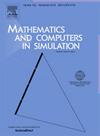Impact of cross-diffusion and Allee effect on modified Leslie–Gower model
IF 4.4
2区 数学
Q1 COMPUTER SCIENCE, INTERDISCIPLINARY APPLICATIONS
引用次数: 0
Abstract
A modified Leslie–Gower model with cross-diffusion and Allee effect is studied. First temporal dynamics of the system is analyzed and the existence of equilibrium points and their corresponding stability analysis are performed. Variation in the Allee effect parameter results in saddle node and Hopf bifurcations. Further, the spatio-temporal model is analyzed and observed that as cross-diffusion gradually increases, prey and predator disperse over the region. Turing instability conditions are derived for cross-diffusion and stability analysis of the amplitude equations is computed to identify the type of the Turing pattern. Analytical conclusions are validated through numerical simulations. As the Allee effect increases, it affects the spatial and temporal dynamics of the prey population. Turing pattern changes from spots to stripes, indicating a large dispersion and a variety of predator interactions, which reduces confinement to secure small areas. In the absence of cross-diffusion, there will be a positive correlation between prey and predator populations. In contrast, when cross-diffusion is present, a negative correlation between prey and predator populations arises.
交叉扩散和Allee效应对修正Leslie-Gower模型的影响
研究了具有交叉扩散和Allee效应的修正Leslie-Gower模型。首先分析了系统的时间动力学特性,给出了平衡点的存在性及其稳定性分析。Allee效应参数的变化导致鞍节点分岔和Hopf分岔。进一步分析了时空模型,发现随着交叉扩散的增加,猎物和捕食者在区域内逐渐分散。推导了交叉扩散的图灵不稳定条件,并计算了振幅方程的稳定性分析,以确定图灵图的类型。通过数值模拟验证了分析结论。随着狭缝效应的增强,它会影响猎物种群的时空动态。图灵图案从斑点变成条纹,表明大的分散和各种捕食者的相互作用,这减少了对安全小区域的限制。在没有交叉扩散的情况下,猎物种群和捕食者种群之间存在正相关关系。相反,当交叉扩散存在时,猎物种群和捕食者种群之间出现负相关。
本文章由计算机程序翻译,如有差异,请以英文原文为准。
求助全文
约1分钟内获得全文
求助全文
来源期刊

Mathematics and Computers in Simulation
数学-计算机:跨学科应用
CiteScore
8.90
自引率
4.30%
发文量
335
审稿时长
54 days
期刊介绍:
The aim of the journal is to provide an international forum for the dissemination of up-to-date information in the fields of the mathematics and computers, in particular (but not exclusively) as they apply to the dynamics of systems, their simulation and scientific computation in general. Published material ranges from short, concise research papers to more general tutorial articles.
Mathematics and Computers in Simulation, published monthly, is the official organ of IMACS, the International Association for Mathematics and Computers in Simulation (Formerly AICA). This Association, founded in 1955 and legally incorporated in 1956 is a member of FIACC (the Five International Associations Coordinating Committee), together with IFIP, IFAV, IFORS and IMEKO.
Topics covered by the journal include mathematical tools in:
•The foundations of systems modelling
•Numerical analysis and the development of algorithms for simulation
They also include considerations about computer hardware for simulation and about special software and compilers.
The journal also publishes articles concerned with specific applications of modelling and simulation in science and engineering, with relevant applied mathematics, the general philosophy of systems simulation, and their impact on disciplinary and interdisciplinary research.
The journal includes a Book Review section -- and a "News on IMACS" section that contains a Calendar of future Conferences/Events and other information about the Association.
 求助内容:
求助内容: 应助结果提醒方式:
应助结果提醒方式:


